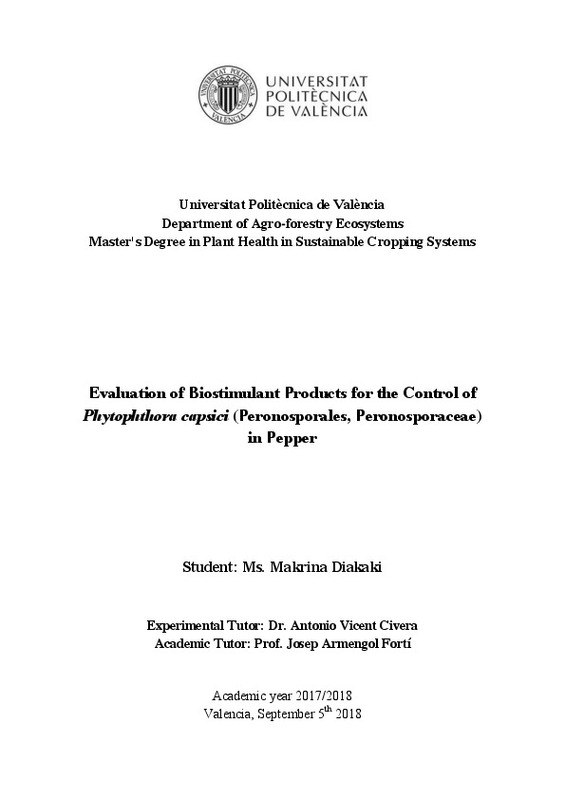|
Resumen:
|
Los bioestimulantes de plantas son productos que "contienen sustancias y/o microorganismos cuya función cuando se aplican a las plantas o la rizosfera es estimular los procesos naturales para mejorar/beneficiar la absorción ...[+]
Los bioestimulantes de plantas son productos que "contienen sustancias y/o microorganismos cuya función cuando se aplican a las plantas o la rizosfera es estimular los procesos naturales para mejorar/beneficiar la absorción de nutrientes, la eficiencia de nutrientes, la tolerancia al estrés abiótico y la calidad del cultivo (EBIC, 2012). Con el objetivo de cumplir con las regulaciones legales de la Unión Europea, una empresa de protección de cultivos facilitó una selección de productos bioestimulantes para determinar su posible fungitoxicidad y eficacia en el control de oomicetos. Estos productos se han preparado comercialmente para el control de las enfermedades causadas por Phytophthora. Los componentes de su formulación están codificados como L01-L13 y los bioestimulantes como A y B. En este estudio, titulado 'Evaluación de productos bioestimulantes para el control de Phytophthora capsici en pimiento', los productos y los componentes de su formulación se estudiaron in vitro y mediante ensayos de invernadero. En los experimentos in vitro se estudió la posible fungitoxicidad frente a los organismos fitopatógenos P. capsici y P. citrophthora, Fusarium solani, Verticillium dahliae, así como Alternaria alternata. Los patógenos se expusieron a diferentes concentraciones de producto y los resultados de la inhibición del crecimiento se analizaron mediante curvas dosis-respuesta y, cuando fue posible, se calcularon también los valores de EC50 (concentración efectiva media). L01-L13 no indujeron en ningún caso una reducción del 50% del crecimiento de los organismos. Lo mismo ocurrió con los bioestimulantes A y B. Los resultados del estudio in vitro indican que ninguno de estos dos productos, ni los componentes de su formulación, resultaron fungitóxicos para los organismos incluidos en el experimento. Los ensayos de invernadero tuvieron como objetivo evaluar la eficacia de los productos A y B para el control de P. capsici en pimiento. Las plántulas se cultivaron durante dos meses y se pulverizaron foliarmente con los productos. Posteriormente se inocularon con P. capsici mediante inmersión de las raíces en una suspensión de zoosporas. La severidad de la enfermedad se evaluó semanalmente hasta la muerte de las plántulas. Los datos de severidad se analizaron mediante modelos de regresión ordinal, calculando los correspondientes odds ratios con las plantas inoculadas no tratadas como nivel de referencia. Todos los productos evaluados presentaron odds ratios entre 0 y 1, concluyendo que ninguno ellos fue efectivo para el control de P. capsici en pimiento bajo las condiciones del experimento. El posible efecto de control de estos productos habría quedado enmascarado por un estrés excesivo de la plantas, inducido por las condiciones extremadamente agresivas de la inoculación, unido a posibles problemas de fitotoxicidad. Por lo tanto, en el futuro sería necesario explorar otras metodologías para evaluar la eficacia de los bioestimulantes A y B en el control de P. capsici en pimiento.
[-]
Plant biostimulants are products which ¿contain substance(s) and/or micro-organisms whose function when applied to plants or the rhizosphere is to stimulate natural processes to enhance/benefit nutrient uptake, nutrient ...[+]
Plant biostimulants are products which ¿contain substance(s) and/or micro-organisms whose function when applied to plants or the rhizosphere is to stimulate natural processes to enhance/benefit nutrient uptake, nutrient efficiency, tolerance to abiotic stress, and crop quality¿ (EBIC, 2012). Aiming to comply with the legislative regulations of the European Union, a plant protection company submitted a selection of biostimulating products to studies of fungitoxicity and oomycete control efficacy. These products are aimed for the control of Phytophthora diseases. The product components were coded L01-L13 and the biostimulants A and B. In this investigation, titled `Evaluation of biostimulant products for the control of Phytophthora capsici in pepper¿, the products themselves as well as their formulation components were studied in vitro and through greenhouse trials. The in vitro experiments involved the target oomycetes P. capsici and P. citrophthora, the soil-borne fungi Fusarium solani and Verticillium dahliae as well as the foliar fungal pathogen Alternaria alternata. The pathogens were exposed to different product concentrations and the results of growth inhibition were analyzed by dose-response curves and, wherever possible, EC50 values (half maximal effective concentration) were calculated. None of the product components (L01-L13) reached an effect of 50% growth reduction. The same was true for biostimulants A and B, and since the results were significant, these products and their components were not considered fungitoxic to the organisms of the study. The greenhouse trials were conducted in parallel and aimed at evaluating the efficacy of products A and B in preventing P. capsici from infecting pepper seedlings. Seedlings were grown for two months, were foliarly sprayed with the products and were subsequently inoculated with P. capsici by root submersion in a zoospore suspension. Disease severity was assessed weekly, until seedling death, and the data were analyzed through ordinal regression models and the calculation of odds ratios. The comparisons were done using inoculated non-treated plants as the reference group. All odds ratios ranged from 0 to 1 suggesting that none of the products achieved to significantly increase the chances of disease control under the conditions tested. It is speculated that the potential benefits of the products against disease were masked by the negative impact that inoculation aggressiveness and phytotoxicity had on plant status. Thus, exploring other methodologies in future trials will be the next step in investigating the topic further and achieving a comprehensive understanding of the efficacy and capacity that biostimulants A and B have in preventing pepper infection from P. capsici.
[-]
|







